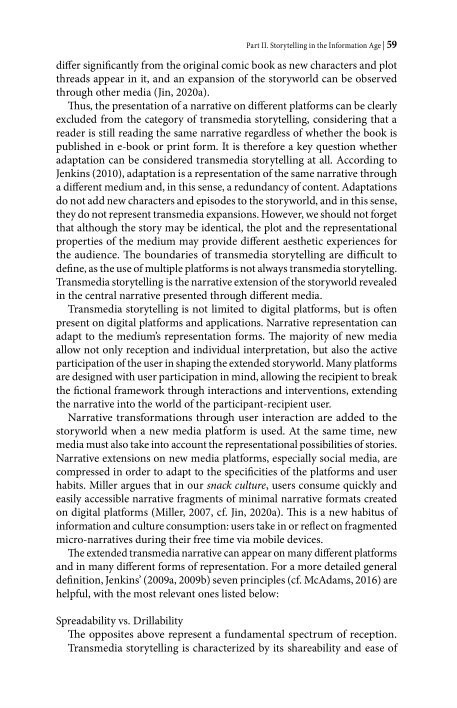

OCR
Part II. Storytelling in the Information Age | 59 differ significantly from the original comic book as new characters and plot threads appear in it, and an expansion of the storyworld can be observed through other media (Jin, 2020a). Thus, the presentation of a narrative on different platforms can be clearly excluded from the category of transmedia storytelling, considering that a reader is still reading the same narrative regardless of whether the book is published in e-book or print form. It is therefore a key question whether adaptation can be considered transmedia storytelling at all. According to Jenkins (2010), adaptation is a representation of the same narrative through a different medium and, in this sense, a redundancy of content. Adaptations do not add new characters and episodes to the storyworld, and in this sense, they do not represent transmedia expansions. However, we should not forget that although the story may be identical, the plot and the representational properties of the medium may provide different aesthetic experiences for the audience. The boundaries of transmedia storytelling are difficult to define, as the use of multiple platforms is not always transmedia storytelling. Transmedia storytelling is the narrative extension of the storyworld revealed in the central narrative presented through different media. Transmedia storytelling is not limited to digital platforms, but is often present on digital platforms and applications. Narrative representation can adapt to the medium’s representation forms. The majority of new media allow not only reception and individual interpretation, but also the active participation of the user in shaping the extended storyworld. Many platforms are designed with user participation in mind, allowing the recipient to break the fictional framework through interactions and interventions, extending the narrative into the world of the participant-recipient user. Narrative transformations through user interaction are added to the storyworld when a new media platform is used. At the same time, new media must also take into account the representational possibilities of stories. Narrative extensions on new media platforms, especially social media, are compressed in order to adapt to the specificities of the platforms and user habits. Miller argues that in our snack culture, users consume quickly and easily accessible narrative fragments of minimal narrative formats created on digital platforms (Miller, 2007, cf. Jin, 2020a). This is a new habitus of information and culture consumption: users take in or reflect on fragmented micro-narratives during their free time via mobile devices. The extended transmedia narrative can appear on many different platforms and in many different forms of representation. For a more detailed general definition, Jenkins’ (2009a, 2009b) seven principles (cf. McAdams, 2016) are helpful, with the most relevant ones listed below: Spreadability vs. Drillability The opposites above represent a fundamental spectrum of reception. Transmedia storytelling is characterized by its shareability and ease of
Structural
Custom
Image Metadata
- Image width
- 1831 px
- Image height
- 2835 px
- Image resolution
- 300 px/inch
- Original File Size
- 1.37 MB
- Permalink to jpg
- 022_000040/0059.jpg
- Permalink to ocr
- 022_000040/0059.ocr
